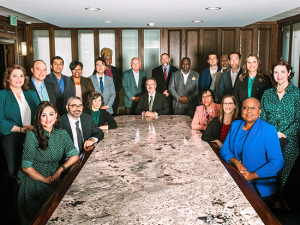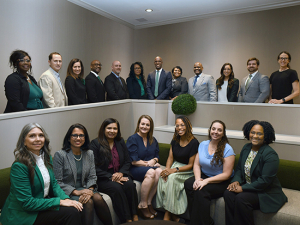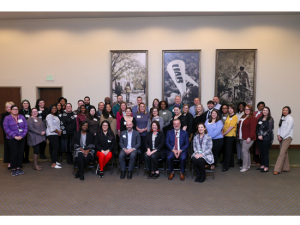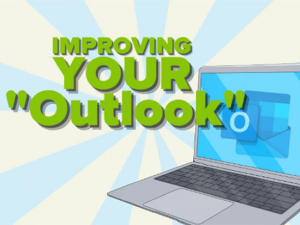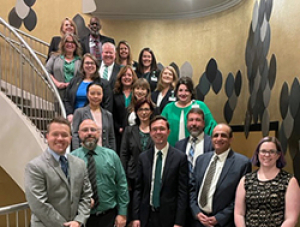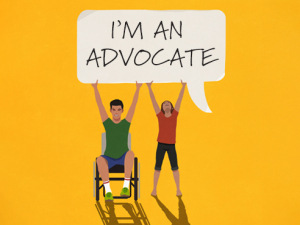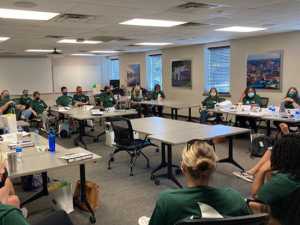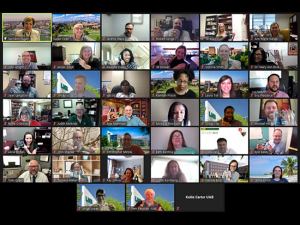 UAB employees identified three key areas for improvement in the 2017 Campus Engagement Survey: communication, career development/leadership and performance management. New programs and initiatives have been launched to address these elements from an administrative standpoint, and everyone can play a part in building a better UAB. During the next few weeks, the Reporter will explore free resources, training opportunities and expert advice to help you hone your skills.
UAB employees identified three key areas for improvement in the 2017 Campus Engagement Survey: communication, career development/leadership and performance management. New programs and initiatives have been launched to address these elements from an administrative standpoint, and everyone can play a part in building a better UAB. During the next few weeks, the Reporter will explore free resources, training opportunities and expert advice to help you hone your skills.
“The single biggest problem in communication,” said Nobel-winning playwright George Bernard Shaw, “is the illusion that it has taken place.” Or did he? Evidence suggests that this clever phrase, or a version of it, was actually written by William Whyte, author of the 1950s classic “The Organization Man,” in an essay on business communication for “Fortune” magazine. Which is entirely appropriate, since the workplace is a setting where miscommunication has some of its most profound effects.
Consider a simple example, says Organizational Development Manager Gerriann Fagan: your manager asks for something ASAP. “Does that mean right now, today, this week or this month? If you ask a room full of people, you’ll get a room full of answers.”
Communicating in a ‘unique time’
Misunderstandings are nothing new. Yet technology and demographics have combined to make communication in today’s workplace particularly challenging. “This is a unique time,” said Randall Kornegay, business communications coordinator in the Collat School of Business and a consultant who has worked with national and regional companies in the area to resolve communications problems. “With baby boomers staying in the workplace longer, there are three, and even sometimes four different generations working together. In addition to the dynamic of manager-to-employee communication, you also have one generation to another. Each generation has a different background and set of acceptable standards and that really can create some conflicts.”
That doesn’t mean there are no solutions. “There are ways everyone can improve their ability to communicate” — and leverage the strengths of a multigenerational workplace, Kornegay said. Here, Kornegay and members of UAB Organizational Learning & Development, which offers an array of workshops and other training materials to improve communication, share their advice and favored resources.
1. Write for mobile
 Clarity has always been important for business communication, but technology has made it essential. “We live in a mobile environment now,” Kornegay said. “Most business professionals do the bulk of their checking of email on their phones, so any message needs to be short and to the point. You have to think about getting your message across and asking the least amount of time from your readers.”
Clarity has always been important for business communication, but technology has made it essential. “We live in a mobile environment now,” Kornegay said. “Most business professionals do the bulk of their checking of email on their phones, so any message needs to be short and to the point. You have to think about getting your message across and asking the least amount of time from your readers.”
Academic writing teaches students to build their argument deliberately toward a conclusion, he explains. “But in the workplace, you have to flip that on its head. Write like a journalist, in descending order of importance. What are you asking someone to do next? If you need help, let the recipient know right up front. That should be in your subject line, or at least in the first sentence or two. The additional details should come after that.
“If you send someone a wall of text, you are going to lose your reader and those messages are going to go to the back of the queue,” Kornegay continued. Pay attention to formatting: include empty whitespace, bullets, bolding and underlining to get your message across in a quick scan.
Learn how: Korengay teaches an undergraduate course, Business Communication, BUS350, that focuses on writing, including reports, memos, emails, social media posts, complaint resolution, persuasive letters and resumes. He also teaches an advanced undergraduate/graduate-level course in Managerial Communication Skills, MG 438/MBA 638, that focuses on both verbal and nonverbal skills. Both courses are offered in person and online. UAB employees can use their Educational Assistance Benefit to take the classes for academic credit without paying tuition (course fees and textbook costs must be paid by the employee).
2. Get prepared
More in this series |
Whether you are addressing a group or having a coaching conversation, the time you take up front to think through your message will help ensure it is received in the way you intended. “You always want to communicate in a way that’s clear and concise,” Kornegay said.
Try It: Kornegay recommends asking yourself these four questions to make sure you’re covering the main points:
- What does my audience already know about this topic?
- What do they need to know?
- What hurdles do they need to get over?
- What is the bias, if any, that they may have toward what I’m telling them?
3. Learn across generations
Communication problems often center on what Kornegay calls workplace etiquette: “Millennials tend to feel more comfortable addressing people across hierarchies, which blurs lines of workplace behavior that boomers or Generation X have ingrained,” he said. “So they may address a supervisor by their first name without being told it’s OK, text their boss to ask for time off or send a friend request to a superior on Facebook.”
 Try It: In a paper published this past fall in the journal The Cooperative Accountant, Kornegay argued for an effective way to cross this generational divide: mentor-protege partnerships. The idea, which has been pioneered in Silicon Valley tech firms, lets seasoned employees teach millennial staff the ins and outs of the organizational culture, while those junior employees share their understanding of how to effectively wield newer communication technologies, such as the latest social media platforms. “That way, new hires aren’t expected to figure out the culture on their own,” Kornegay said. “They have a guide, while the younger hires help their managers stay current with technology. It’s a back-and-forth partnership.” And research shows that these partnerships improve retention of new hires. “Millennials feel more loyal to the people they work with than the organization itself,” Kornegay said. “If they feel like they’re working as part of a team it is easier to retain them.”
Try It: In a paper published this past fall in the journal The Cooperative Accountant, Kornegay argued for an effective way to cross this generational divide: mentor-protege partnerships. The idea, which has been pioneered in Silicon Valley tech firms, lets seasoned employees teach millennial staff the ins and outs of the organizational culture, while those junior employees share their understanding of how to effectively wield newer communication technologies, such as the latest social media platforms. “That way, new hires aren’t expected to figure out the culture on their own,” Kornegay said. “They have a guide, while the younger hires help their managers stay current with technology. It’s a back-and-forth partnership.” And research shows that these partnerships improve retention of new hires. “Millennials feel more loyal to the people they work with than the organization itself,” Kornegay said. “If they feel like they’re working as part of a team it is easier to retain them.”
4. Listen with your ears — and eyes
“Listening is the key to successful communication,” Fagan said. That includes paying attention to body language, facial expressions and other subtle clues — as well as words. It is easy to get distracted. While the average person speaks 125 words per minute, we can process up to 500 words per minute. The person you are speaking with also is alert to your cues, including signs of impatience or boredom. Psychologist Albert Mehrabian proposed the 7–38–55 rule: words account for only 7 percent of personal communication, he said, while 38 percent is a person’s tone of voice and 55 percent is body language.
Try It: To cope with distraction, imagine yourself in the other person’s movie: picturing things from their perspective as the narrator and taking the journey with them.
Read Up: The movie technique is featured in Rebecca Shafir’s book “The Zen of Listening: Mindful Communication in the Age of Distraction.”
Learn How: Sign up for Learning and Development’s Effective Listening Skills workshop, which uses a five-step process to make anyone a better listener. The next workshop is 9-11:30 a.m. Dec. 13; register online at uab.edu/learningsystem. Learn more at uab.edu/learndev.
Read this one-page LearnNow guide from Learning and Development on active listening.
5. Know your audience
Good communication is tailored to the receiver, Fagan noted: “Some people prefer face-to-face discussions, while others prefer emails.” The DISC model may be helpful to learn more about yourself or your team; it uses an assessment to evaluate behavioral styles in four areas: Dominance, Influence, Steadiness and Conscientiousness.
 Learn How: Learning & Development offers DISC assessments to help individuals and teams understand their behavioral styles, recognize the styles of others and adapt communications for improved results. Register online at uab.edu/learningsystem. Learn more at uab.edu/learndev.
Learn How: Learning & Development offers DISC assessments to help individuals and teams understand their behavioral styles, recognize the styles of others and adapt communications for improved results. Register online at uab.edu/learningsystem. Learn more at uab.edu/learndev.
Try It: Improve team communication with the popular Marshmallow Challenge, as featured in Tom Wujec’s “Build a tower, build a team” TED Talk. Can your group figure out how to make a tower out of a marshmallow, dry spaghetti and one yard of tape? Conversations will definitely ensue.
6. Avoid “moving the furniture”
Managers often struggle to properly coach their employees, especially when it comes to communication. “Avoid the, ‘I would have done it differently’ comment,” Kornegay said — and the urge to just rewrite employees’ work without explaining what needs to be changed. “I call that ‘moving the furniture around,’” he said. “It creates animosity and anxiety.”
Learn How: Learning and Development’s Developing Others through Coaching program teaches practical questions and skills to build basic coaching prowess. Participants are encouraged to bring first-hand scenarios to practice. The workshop is part of the Management Fundamentals series. Learn more at uab.edu/learndev.
Read these one-page LearnNow guides from Learning and Development on giving and receiving feedback and coaching.
Read Up: “Thanks For the Feedback: The Science and Art of Receiving Feedback Well,” by Sheila Heen and Douglas Stone, describes methods for making the most of even difficult evaluations, offhand comments and unsolicited input.
7. Let the air out of stressful situations
Most people are naturally anxious about certain types of communication, such as a high-stakes presentation or an upcoming performance review. Relaxation techniques and exercises, such as progressive muscle relaxation, guided imagery, mindfulness meditation and diaphragmatic breathing, are “great for managing stress,” said David Knight, Ph.D., associate professor of psychology. These techniques can be learned, he added, “and there is good evidence that a person’s ability to regulate their emotions would improve by practicing these exercises.”
 Knight, who studies the molecular basis of emotion, learning and memory in the brain using neuroimaging, says that this type of research could help individuals find the most effective therapy — and even point to new therapies. “Real-time fMRI has been used to provide biofeedback (in the lab) to participants in studies to help them regulate their emotions,” he said. “Alternatively, neuroimaging could be used to identify neural markers that could help with treatment selection.”
Knight, who studies the molecular basis of emotion, learning and memory in the brain using neuroimaging, says that this type of research could help individuals find the most effective therapy — and even point to new therapies. “Real-time fMRI has been used to provide biofeedback (in the lab) to participants in studies to help them regulate their emotions,” he said. “Alternatively, neuroimaging could be used to identify neural markers that could help with treatment selection.”
Try It: The UAB Employee Assistance and Counseling Center teaches mindfulness skills through its free online Stress Management Initiative for Lifestyle Enhancement (SMILE) program. Log into the UAB Learning System with your BlazerID and password and search “Smile.” SMILE is part of the Code Blaze stress-minimization program, which also includes special Quiet Rooms that are stocked with iPads with access to stress management apps and other resources.



